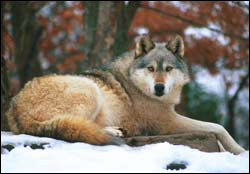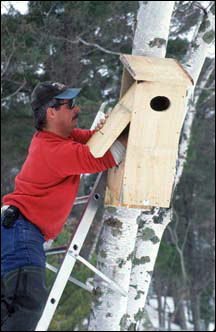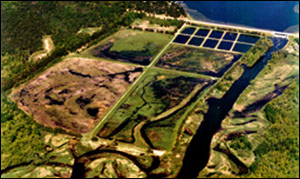Wildlife
 The Wildlife Program within the Division of Resources Management works to protect and enhance wildlife populations on the Reservation for current and future generations of tribal members. The Leech Lake Reservation is located near the junction of three major biomes (habitat types), including the boreal forest, northern hardwoods forest, and the tall grass prairie. This results in us having a very high diversity of wildlife species. There are approximately 58 species of mammals that occur on the reservation, 243 species of birds, 27 species of reptiles and amphibians, along with untotaled numbers of invertebrates like insects.
The Wildlife Program within the Division of Resources Management works to protect and enhance wildlife populations on the Reservation for current and future generations of tribal members. The Leech Lake Reservation is located near the junction of three major biomes (habitat types), including the boreal forest, northern hardwoods forest, and the tall grass prairie. This results in us having a very high diversity of wildlife species. There are approximately 58 species of mammals that occur on the reservation, 243 species of birds, 27 species of reptiles and amphibians, along with untotaled numbers of invertebrates like insects.
Habitat Enhancement
The wildlife program has undertaken, and participated in, many habitat enhancement programs over the years. These activities are frequently used as a means of providing or improving habitats that are in short supply due to human impacts to the environment.
Prescribed Burning
Historically fires were common in the lowland sedge meadows that are found along many of our lakes and major rivers, as well in the dry upland pine forest. In the case of sedge meadows these fires kept these areas open and provided nesting cover for species that utilize these habitats. In the upland pine forests fire promoted the regeneration of pine species and kept these areas from being taken over by hardwood species. Although is it difficult to put fire back onto the landscape to the degree it historically occurred, we conduct prescribed fires in situations where it is safe and it will benefit habitats and the species that utilize them.
Impoundments
We have worked in cooperation with the Chippewa National Forest for the management of many of the impoundments that are located on the reservation. Most of these impoundments were built to provide habitat for waterfowl and other species that require open waters. Some impoundments are also utilized for bait harvesting. This work includes general maintenance and management, draw downs to promote wetland vegetation.
Nest boxes
The wildlife program has for may years been constructing, installing, and maintaining nest boxes, primarily for waterfowl like woodducks, common goldeneyes, and hooded mergansers. Due to extensive timber harvest, that has occurred in this area, most trees never get large enough to develop natural cavities in them. As a consequence there is a shortage of nesting cavities for many species that use them. Providing artificial nest boxes is a way of lessening this loss until such time as forest management practices can be improved so they can accommodate this need.

Winnie Ponds Fish and Wildlife Management Area
The Winnie Ponds Fish and Wildlife Management Area was constructed in the 1950s by the Minnesota Department of Natural Resources to rear walleye fingerlings. The large ponds proved to be difficult to manage for this purpose and operations ceased in the 1970s. Legislation passed by the State of Minnesota allowed the area to revert back to the Band and we start managing the area in the 1990s. The Band’s Fisheries Program subdivided one of the ponds into smaller, more manageable ponds that are used to rear fish, while the remainder is used for wildlife management, primarily waterfowl. They continute to be managed for wildlife and there is also an interpretative trail on the site with an observation platform.

Common Tern Nesting Habitat
One of the last four remaining colonies of common terns in Minnesota, nest on tribal lands out in the middle of Leech Lake. This is a species that has declined dramatically due to predation, human disturbance, and competition with other colonial waterbirds. In an effort to prevent the loss of this colony and to enhance their reproductive success the reservation has constructed island stabilization projects to reduce habitat loss and to give the terns a safe place to nest. Predators are also removed from the islands and cormorant numbers have been reduced to prevent them from taking over the islands.
Contact Us
DRM (218) 335-7400
| Name | Title | Phone |
| Mortensen, Steve | Fish, Wildlife & Plant Resources Program Director | 335-7421 |
| Finn, Jon | Fish & Wildlife Field Specialist | 335-7424 |
| White, Gary | Assistant Hatchery Manager | 335-7424 |
| Robinson, Martin | Fish and Wildlife Technician | 335-7424 |















 Division of Resource Management
Division of Resource Management